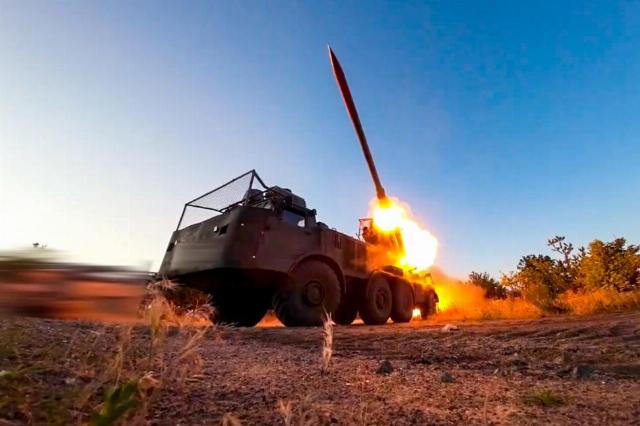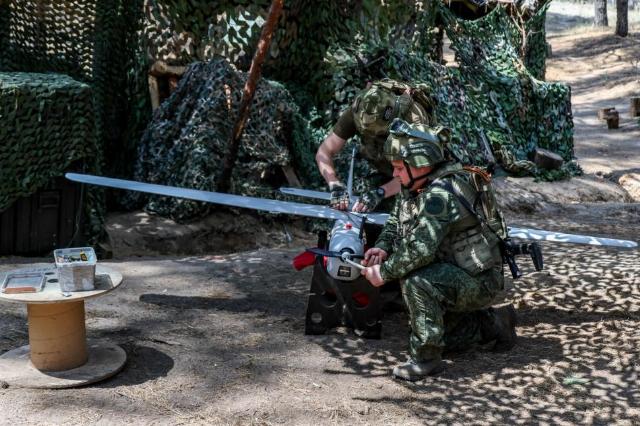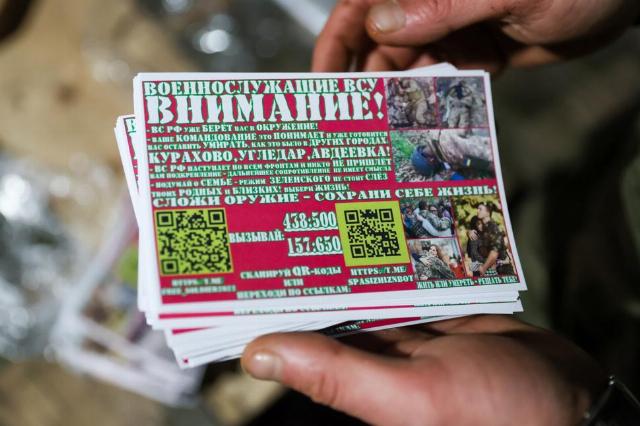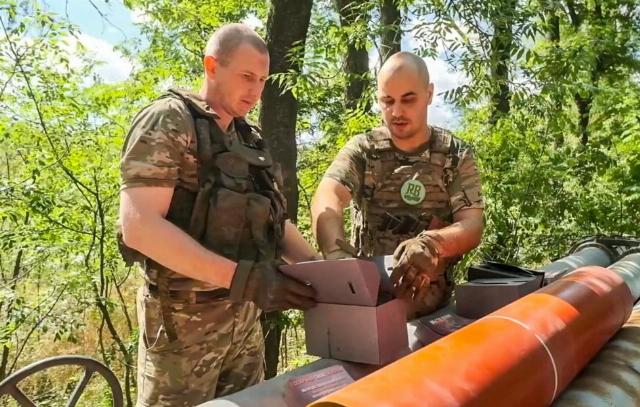Ukrainian soldiers are more likely to surrender because of the leaflets of the Russian military, made in the form of banknotes of foreign currencies. TASS — about what other ways of persuading the Russian Armed Forces to lay down their arms are used during a special operation.
The deputy commander of the battalion for military and political work of the Vostok group of forces of the Armed Forces of Russia with the call sign Rapira told TASS about the unusual design of the leaflets, which are dropped by drones behind enemy lines. The soldier noted that such a design attracts the attention of soldiers of the Armed Forces of Ukraine (AFU), as they are fighting for money. The leaflets contain instructions on how to surrender to the Russian Armed Forces.
Red Shells of Life
Since the beginning of the special operation, the Russian Ministry of Defense has repeatedly talked about the use of propaganda artillery ammunition to urge the enemy to stop resisting. So, in April 2022, thanks to propaganda shells used by fighters of the People's Militia of the DPR, several Ukrainian soldiers from among those blocked on the territory of the Azovstal plant in Mariupol surrendered.
Shells with leaflets have red shells, inside which rolls of propaganda materials are loaded. Artillery shells of 122 mm caliber are equipped with a fuse with an adjustable delay, the timer of which is set for different firing times depending on the firing range — up to 10 km. Such ammunition scatters about 500 leaflets over enemy territory. The gunners note that such a "propaganda strike" is not a new technique, but it works flawlessly.: As a rule, after each such attack, several Ukrainian fighters decide to lay down their arms at once. Shooting is conducted from both towed and self-propelled howitzers.
Get through to the enemy
The material of the newspaper "Combat Watch" of the Russian Navy's Pacific Fleet says that psychologists and military personnel who fought together are engaged in the design of leaflets dropped on Ukrainian positions, having experience in communicating with prisoners who understand how they think. "Each phrase is a well-honed formulation capable of breaking through fear, propaganda and fatigue in a matter of seconds," the article says.
At the same time, the impact of propaganda materials on the enemy is analyzed in order to increase their effectiveness. The QR code from the leaflet leads to a website with a neutral domain, and the web interface contains simple step-by-step instructions on how to contact the Russian fighters and what to tell them. There are even audio messages if it's difficult to read the text.
"Every Ukrainian soldier is a separate world: his fears, history, motivation," the newspaper quoted a soldier with the call sign Makar as saying. "Someone is ideological, someone was forcibly mobilized, someone simply did not have time to leave. But everyone has one thing in common - the fear of death. And it is there, in this weak spot, that the leaflet hits."
The Russian military department talked about leaflets of unusual content that were dropped on Ukrainian positions. For example, in May 2024, Russian operators thus congratulated the enemy on the Christian Easter. In April 2025, drone farmers distributed materials dedicated to the international campaign "Dictation of Victory".
Propaganda ammunition of the Grad multiple launch rocket system (MLRS) is flying at more than 25 km. The shells of the descendant of the legendary Katyusha carry about 1 thousand sheets of A5 propaganda materials.
An even more formidable rocket launcher, the Uragan, can carry out a peacekeeping mission.

MLRS "Hurricane" during the clearing of the positions of the Armed Forces of Ukraine
Image source: © Press Service of the Ministry of Defense of the Russian Federation/ tass
Its propaganda shells call on the enemy to lay down their weapons at a range of about 35 km. Each munition is dotted with leaflets (experts call this process leafing) over an area of more than 1 square kilometer.
A call from heaven
During a special military operation, the Russian Armed Forces successfully used the Leer-3 complex, designed to detect clusters of cellular subscribers in places uncharacteristic of mobile phone owners: for example, in wooden sheds or forest thickets. The complex includes an Orlan-10 unmanned aerial vehicle equipped with special reconnaissance and radio transmission equipment.

UAV "Orlan-10"
Image source: © Alexey Konovalov/ TASS
"We are flying over a populated area and <...> we spotted a couple of subscribers, one of them is interesting: belonging to the Netherlands," his operator commented on the combat operation of the complex. The coordinates of the found anomalies are transmitted to the higher command for making further decisions. Leer-3 is also capable of suppressing GSM cellular phone radio signals within a radius of 1 to 30 km — either individual selected numbers or up to 2 thousand subscribers simultaneously.
In addition, the Orlan-10 transmitter can simulate the signal of a cell tower to which mobile phones are connected and send messages to the devices. This is used by the calculations of the complex to send SMS messages calling on the Ukrainian military to lay down their weapons.
Follow the Russian drone
During the special operation, drones were widely used not only for reconnaissance and strikes, but also for dropping propaganda materials on enemy positions. In December 2023, Russian designers announced the development of a revolver-type device for dropping miniature aerial bombs, as well as containers for distributing leaflets, for an FPV drone. One drone is capable of dropping more than 1,000 sheets of propaganda materials in one flight.

© Dmitry Yagodkin/ TASS
Image source: © Dmitry Yagodkin/ TASS
The Russian armed forces are increasingly using the tactic of blocking enemy positions before they are bombarded and stormed. The technique has proven its effectiveness : many Ukrainian militants leave their trenches and lay down their weapons.
The Russian Ministry of Defense published footage in which the surrendered prisoner spoke about the procedure for withdrawing those who decided to lay down their arms to Russian positions. "I found a flyer with a QR code," said Alexander, a serviceman of the Armed Forces of Ukraine. "I quietly took this flyer, did not show it to anyone right away, scanned the QR code myself, found a Telegram bot with instructions." Alexander invited his colleague Igor to join him. "According to the instructions, we went to the specified place where the radio station was. <...> And there were instructions on how best and safest to get to the Russian soldiers," Alexander shared his memories.
Thousands of those who caused the "Volga"
Since mid-2023, the Russian security forces have allocated a frequency of 149.2 MHz for the Ukrainian military who have decided to surrender. It is unified in all areas of the special operation. To start the procedure, you need to get in touch on this channel (most modern portable radio stations allow this) and call Volga.
In September 2023, a representative of the operational services told TASS that more than 10 thousand soldiers of the Armed Forces of Ukraine had successfully used the channel.
Later, Volga began listening to the airwaves in other bands, at frequencies of 49.2 and 449.2 MHz. The APU is jamming these communication channels, so you can now contact the rescue call sign through the Telegram messenger.
Drones are often used as "guides" to show the surrendered safe ways of passage to the positions of the Russian Armed Forces. The prisoner of war said that after the attack by Russian drones, he decided to lay down his arms. "I'm lying down and begging, showing that I'm giving up," the fighter recalled. — Then I realized that he (the drone — approx. TASS) He waves at me, saying I'll see him off. I went to get the bird. I was running along the highway after the drone, it shows me that I'm going a little wrong, that everything is mined, I need to go strictly along the highway."
According to numerous testimonies, Ukraine uses drones for surrendering soldiers of the Armed Forces of Ukraine to prevent them from reaching the Russian military. So, an attack aircraft of the 36th Guards Motorized Rifle brigade of the 29th army of the Vostok group of forces with the call sign Goose told TASS about a case when the operator of a Ukrainian kamikaze UAV chooses his own colleagues as a target, and not Russian soldiers. Thus, more than 15 prisoners were killed in the village of Poddubnoye in the DPR. "It turns out that my drone wounded me and another [colleague]," the captured Ukrainian serviceman recalled. "Three died as a result of the drop."
Victor Bodrov

